Explore La Manche, a Beautiful Corner of Normandy

Hands up if you’ve ever left one of France’s Channel ferry ports and driven on without stopping to discover this area. Rachel Ifans pulls over and finds plenty to see and do in this breathtaking corner of Normandy
If I had a euro for every time someone in La Manche said to me, Ça dépend des marées, I’d be snapping up one of those cute beach huts in Barneville-Carteret and sliding into early retirement. The rhythm of the sea affects most ocean-facing coasts, of course, but the western shores of La Manche have some of the highest tides in Europe, so their landscapes – and the activities of the people who live here – are utterly transformed twice a day by the coming and going of the water.
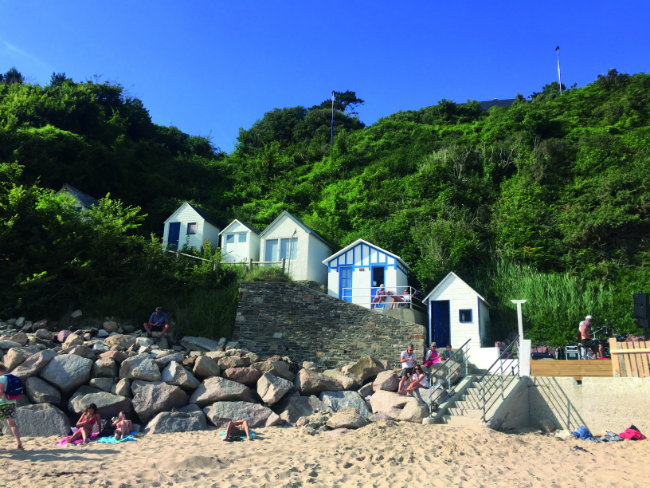
A row of beach huts at Barneville-Carteret. Photo: CDT 50
I’m recalling a road trip I took that started at Mont-Saint-Michel and floated north up the western coast before drifting over to the east and finally mooring at La Manche’s biggest town, the port of Cherbourg. It only took a few days for me to become intoxicated by the tides and impressed with the rest.
Mont-Saint-Michel, my first stop, must be one of the few tourist sites that has improved in recent years. It’s easy to assume that popular places just get busier, tackier and less attractive as the modern world grinds on, but that’s not true here. A long, low-stilted bridge built in 2015 has rid the Mont of the excessive traffic that used to clog up its approach; it has also eradicated silt-clogging, or ensablement, as they call it here. The bridge allows water to flow freely around the bay, restoring the Mont to island status for the first time in more than 130 years.
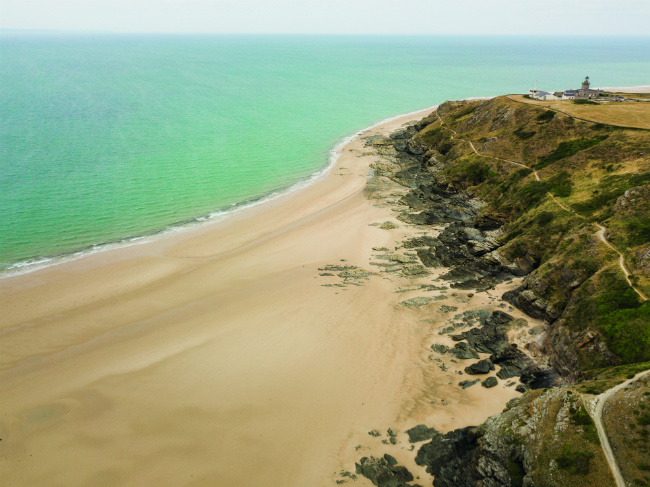
View over the long beach at Barneville-Carteret. Photo: G Mignard/ CDT 50
Mont-Saint-Michel and its bay have been a UNESCO World Heritage Site since 1979, but the abbey is the main draw, a centuries-spanning monastic monolith plonked on top of a huge granite rock. I visited in the peaceful early hours, the sound of the alarm call on my overnight ferry still fresh in my ears. The advanced engineering required to build the abbey over the centuries is astonishing, in particular at the Merveille, a the 13th-century addition in the form of two three-storey buildings, and in the 10th-century nave that started it all, a glorious kernel from history nestled among centuries of subsequent development.
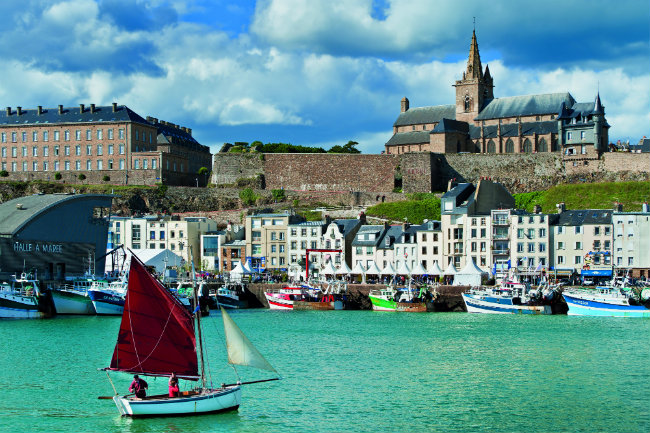
The port of Granville. Photo: M Lerouge
After my abbey tour I ventured out into the massive expanse of the bay. I took a three-hour barefoot walk with a registered guide to the mini mont of Tombelaine, a small tidal island a few kilometres away. A guide is essential due to the unpredictable sinking sands of the bay and the sea’s fearsome currents. We walked on rock-hard sand that bent our feet with its tidal ripple mounds. Then the hard sand suddenly turned squidgy and we slipped onwards with sludgy mud oozing between our toes. Apparently it’s quite possible to find yourself waist deep in the gloop, terrifyingly unable to pull yourself out before the tide washes over you. Our walk saw none of this threatened danger, even though we waded through strong currents and even found ourselves following instructions to form a circle and stamp around it in unison to create a trampoline effect in the sand on which our guide bounced up and down.
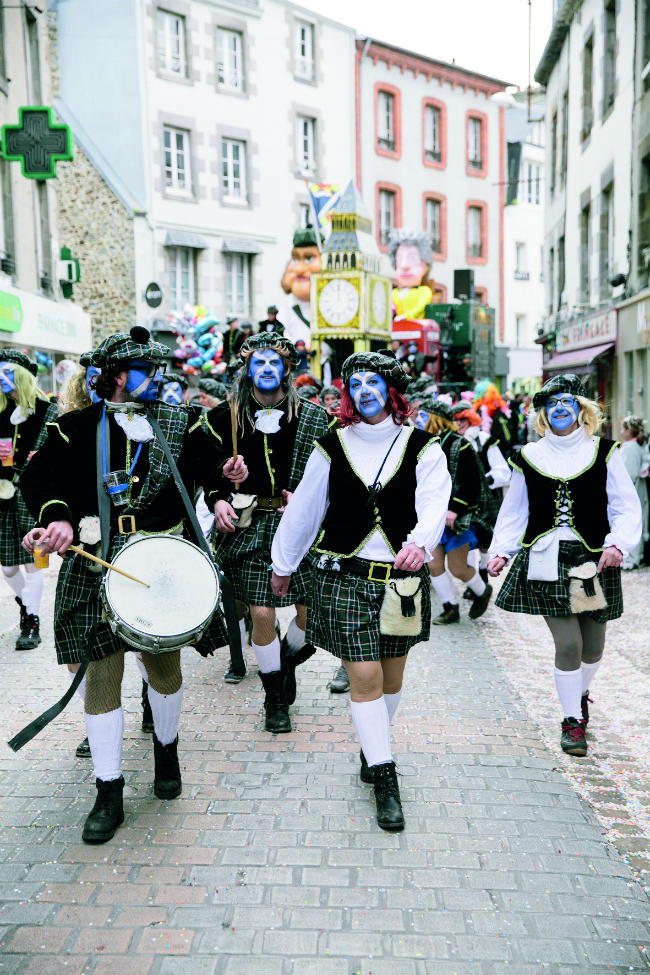
Carnival at Granville. Photo: Alice Bertrand/ CDT50
PLEASURE PORT
Granville is a slightly sprawly port town about 20 kilometres north of Mont-Saint-Michel. It boasts the premier sailing school in France, with a youth hostel attached and a wet dock where the students can learn to sail regardless of the tide. Sailing is on the regular school curriculum here, too, so local children come to learn the ropes as well. There is a port de plaisance here that doesn’t demand a permit, so there is a steady stream of sailors coming in and out from the UK and the Channel Islands. Rue du Port has a number of fantastic fish restaurants, and if you’re lucky enough to visit at the end of September you can buy your fish directly from the fisherman, for one night only at the Toute la Mer sur un Plateau festival.
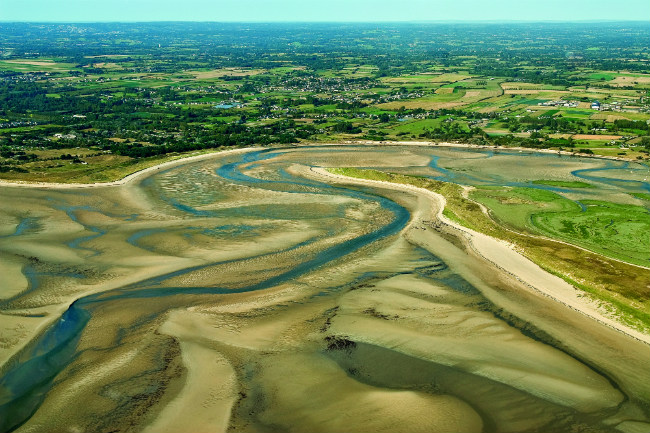
When the tide is out at Le Havre de la Vanlée, lamb graze on the salt marshes that are revealed by the receding sea. Photo: Marc Lerouge/ CDT 50
Touring the town at high tide, it’s hard to imagine the boats freeze-framed on the sand, locals fishing on foot in the ports, and bathers running down the beach for a swim in one of the three tidal pools that emerge, complete with diving blocks and lifeguard, when the sea beats its retreat. But by the time I’d walked through the port, up and over Le Roc to see the Marité set sail for Chausey, and then zigzagged through the old town and walked along the seaside promenade du Plat-Gousset to visit Christian Dior’s childhood home, the port had been transformed into beach chic.

Low tide at Chausey – this stretch of coast also has some of the largest tidal ranges in Europe. Photo: CDT 50
I left Granville on the main road north but soon got blown towards the coast again. Bordering the fields, the golden sheen of the carrot, leek and cabbage crops rippled defiantly in the strong wind that often blows here. I stopped the car at Le Havre de la Vanlée, a low-lying expanse of fields edging the dunes, to admire the agneaux de pré-salé, salt-marsh lambs that can stand the salty grass here, and whose meat – a local delicacy – takes on a special taste as a consequence of their diet.
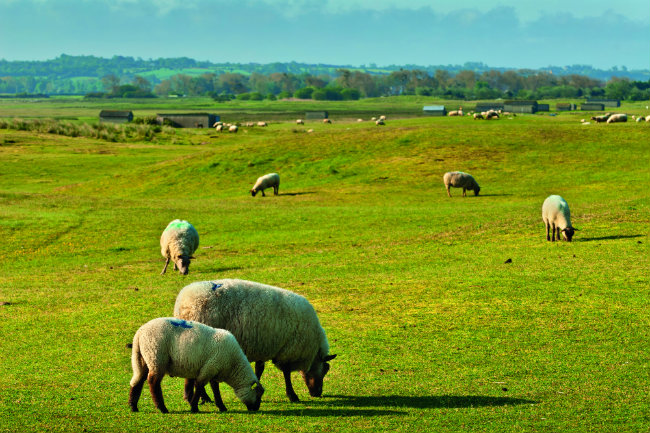
Sheep grazing at Le Havre de la Vanlée. Photo: Marc Lerouge/ CDT 50
MEDIEVAL CASTLE
Regnéville-sur-Mer, a little further up the coast, has a beautiful end-of-the-world feel. Its medieval castle used to border the sea but now sits a kilometre or two away from any water. There’s a campsite, a restaurant, a tableau of beached boats to stare at, and that’s about it. Except, of course, for the incongruous but well-stocked material shop and the disused railway station that’s been turned in to a café and brocante.
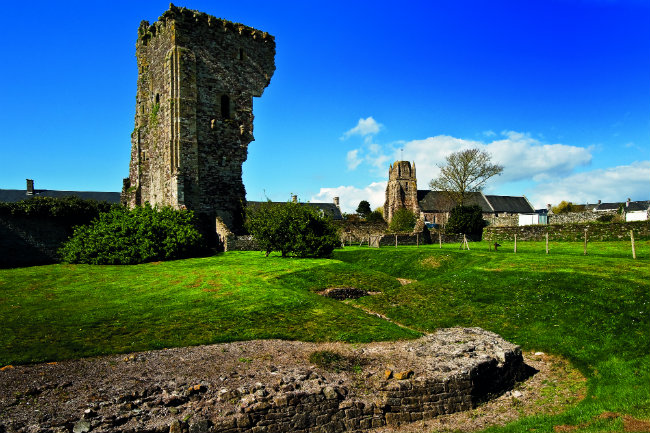
The castle at Regnéville-sur-Mer used to be on the coast but is now a little way inland. Photo: Marc Lerouge/ CDT 50
Moving north again I treated myself to a brief stop in vibey Agon-Coutainville, and dipped into the inspiration that is La Sucette Chaude – confiseurs of distinction since 1930. That day it was a bag of chiques that caught my eye but it could have been berlingots, marshmallows, ice cream or candy floss.
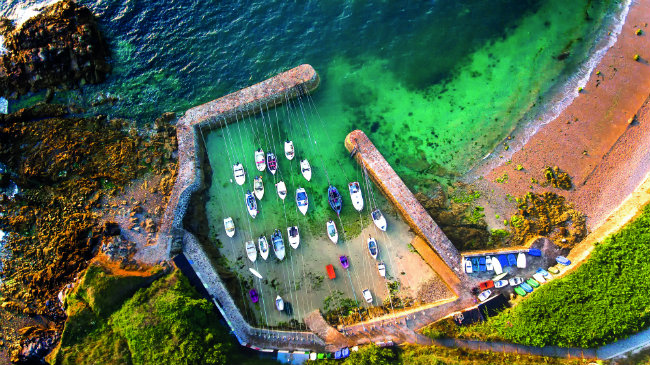
Port Racine, on the northwestern tip of the Manche peninsula, was constructed in the late 19th century on the foundations of a Napoleonic pirate shelter. Photo: Jimmy Perrotte/ CDT 50
Gouville-sur-Mer, with its colourful beach huts and its horse-and-carriage ride out to the oyster beds at low tide, gives way to Barneville-Carteret, my destination for the night. With a beautiful beach, a great coastal path for walking, Belle-Époque villas, and a wonderful hotel-restaurant, this northernmost overnight stop on my trip was the best of them all.

A La Sucette Chaude. Photo: Estelle Hertault/ CDT 50
After the balmy beach of Barneville-Carteret, I didn’t expect what I got from the headland at the northern tip of La Manche. To say my trip to the Nez de Jobourg was windy would be undercooking it somewhat. The cliffs on which I was precariously balanced, navigating my way along gusty coastal paths, not even smiling at the wind-ravaged walkers approaching me as I hugged the hillside as we passed, are, at 128 metres, among the highest in Europe. It is often windy; houses here are built, often with stone or brick roofs instead of tiles, in huddles to protect them from the elements. And the sea in the narrow stretch that separates the mainland from Alderney has the strongest currents in continental Europe and can only safely be navigated for about an hour each day.
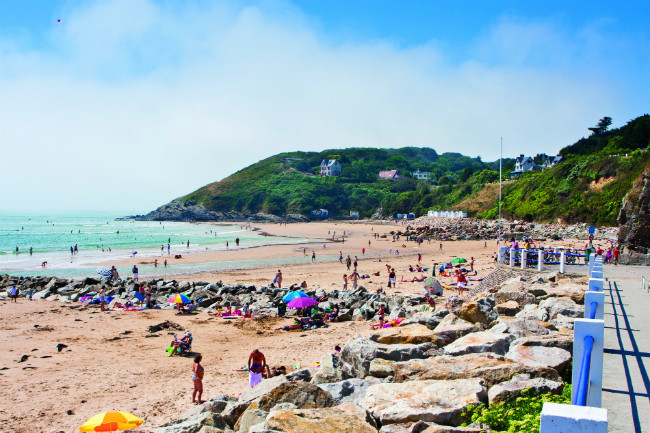
Barneville-Carteret is the main seaside resort. Photo: Thierry Houyel/ CDT 50
I drove from the Nez de Jobourg to Goury and its rescue station; this area is nicknamed La petite Irlande and it does look very much like the Emerald Isle. I then headed on to Port Racine, one of France’s smallest ports, built on the site of a refuge for the corsair schooner L’Embuscade (the Ambush), which was once the scourge of British vessels sailing to, from, and sometimes even just near the Channel Islands.
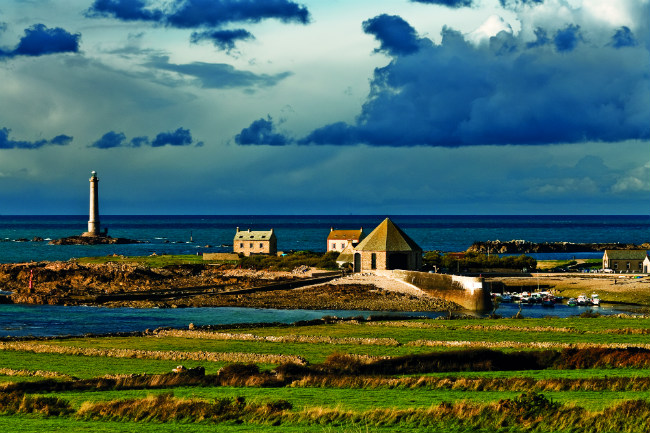
Goury is famous for its impressive sea rescue station. Photo: Marc Lerouge/ CDT 50
WEST MEETS EAST
Two stops remained on my road trip. First I criss-crossed the peninsula to explore the history of the eastern coast. Basing myself in the bustling port of Saint-Vaast-la-Hougue, I enjoyed a day trip to the nearby island of Tatihou. The island museum tells of the Battle of La Hougue in 1692, the shipwrecks of which can still be seen at low tide. You can buy tickets in the billeterie on the harbour front for the amphibious bus/boat to the tiny island. It takes ten minutes to sail across at high tide and by the time I’d wandered through the botanical gardens, visited the museum and the Vauban remains, the tide had lowered enough to put the wheels in motion. We chugged back on a circuitous route through oyster beds.
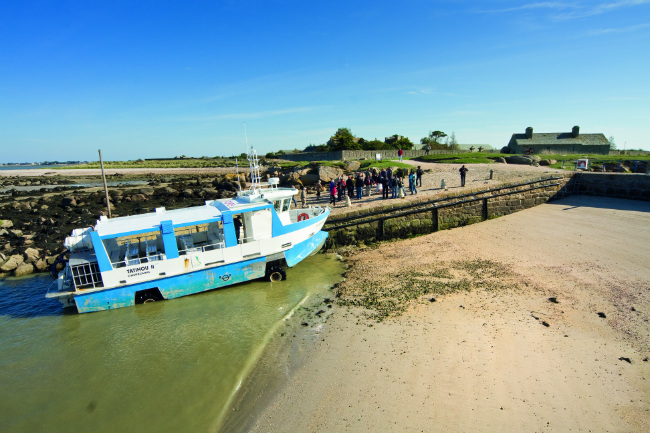
The amphibious Tatihou ferry is converted according the tide. Photo: Thierry Houyel/ CDT 50
No trip to Normandy would be complete without visiting the D-Day landing beaches, and the most westerly of the five sites, Utah Beach, is in the département of La Manche. I boned up on my Second World War history here and at the neighbouring village of Sainte-Mère-Église, where the successful mission by US soldiers to liberate Normandy took place, and then ended my trip in Cherbourg, at the Cité de la Mer museum, before setting sail for Portsmouth.
I hadn’t covered so many miles on my mini road trip around the coast of La Manche, yet I had been amazed by the landscape of the peninsula. Its rough seas make it so atmospheric and its high tides mean the coastline changes dramatically from white sandy beaches to rugged cliffs and isolated islands. There will be plenty more to see when I return.
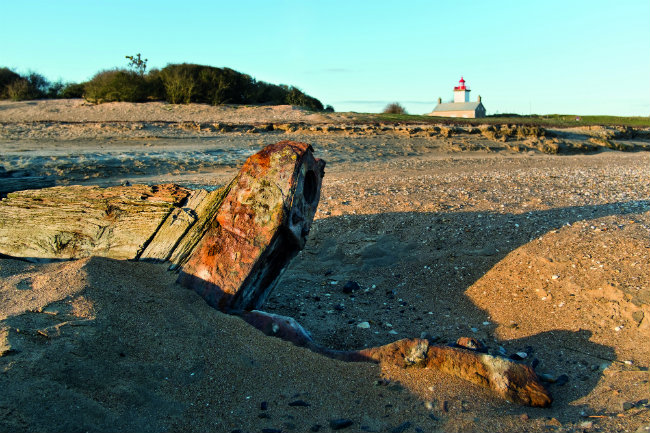
The lighthouse at Pointe d’Agon. Photo: Marc Lerouge/ CDT 50
SIDEBAR: MUSÉE CHRISTIAN DIOR
Sometimes you come away from a famous person’s childhood home and you feel a twinge of cynicism: they only lived here for a short time, is this just milking a tenuous link?
That’s not the case here. Although Dior only lived in this pink Anglo-Norman villa on Granville’s cliff less than a decade, his connection and love for the house is clearly real and moving.
He would later write in his diaries: “I have the most tender and amazing memories of my childhood home. I would even say that my life and my style owe almost everything to its site and architecture.”
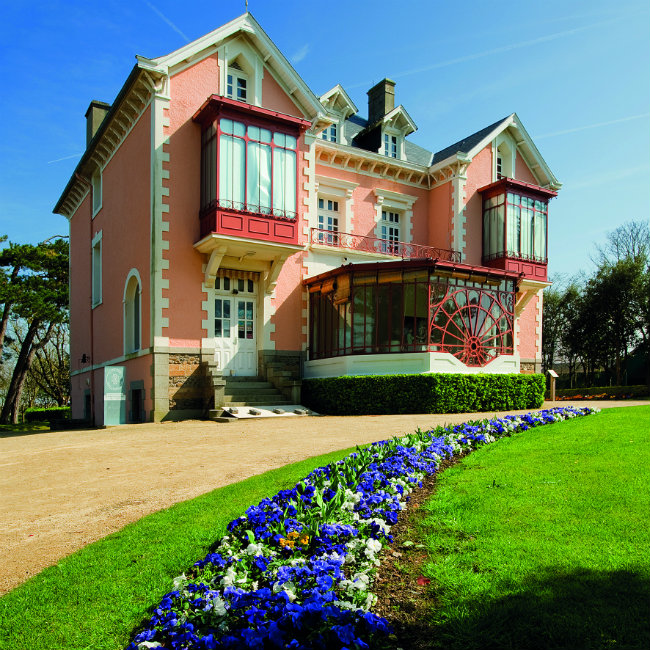
Christian Dior Museum. Photo: Marc Lerouge Photographie/ CDT 50
The stories you pick up of this very private man as you walk around the house and meander through the gardens are really memorable – all the bits and bobs, the drawings, the pieces of his work, the film showing how some of his more intricate dresses were made, and the plans showing how the house was going to be altered when it became a base for British soldiers during the war.
The garden is said to have inspired him more than anything else, and much of the original planting plans – which he made with his mother – are still in place today.
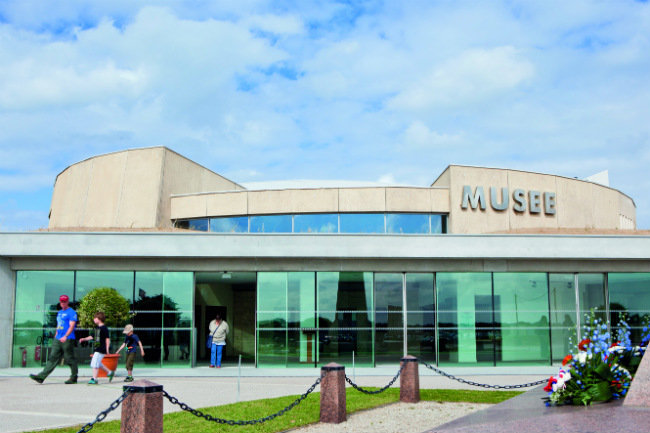
The Utah Beach Museum. Photo: Thierry Houyel/ CDT 50
D-DAY REMEMBRANCE TOURISM
The Airborne Museum at Sainte-Mère-Église commemorates the bravery and hard work of the US paratroopers who made this area their dropzone when attempting to liberate Normandy from German occupation in June 1944. The museum is small but it really brings its story to life within its three main buildings. The first building houses a WACO glider, the second a C-47 plane and the third, and most modern, a pulse-quickening reconstruction of what is was like to be a paratrooper that night, dropped blindly into Normandy’s hinterland.
Some of them found they were fatally heavy, with all their accessories, kit and supplies hanging off them, and sank to a grisly death in the marshland. Others, like John Steele, didn’t even touch the ground. He got snagged on the tower of Sainte-Mère-Église church and had to dangle there pretending to be dead to put the enemy off the scent. A dummy hangs on the church in the village today and Steele is something of a celebrity in the area.
It is just a few kilometres from here to the Utah Beach Museum, which houses some interesting wartime vehicles and tells the story of how the US soldiers, who’d been trained up in England, finally took control of Normandy via its beaches. Some 21,000 soldiers were brought onto Utah Beach that day. The museum’s jewel is its B-26 bomber, which was bought with funds from the sons of one of the American fighter pilots who survived the war. On a visit to Utah Beach they found their father’s details in the records and were moved to raise the cash for the museum to be able to buy and display the plane.

The City of the Sea. Photo: CDT 50
LA CITÉ DE LA MER
The City of the Sea is a museum dedicated to man’s adventures under the sea. It’s in Cherbourg, right on the port, and has two unique exhibitions. The building itself is one large monument to Art Deco architecture, and while this is reason enough to visit, the highlights are Le Redoutable, a huge submarine you can explore with audio guides for adults and children; and the Titanic exhibition, a fully-featured digital experience showing what life was like on board the doomed vessel as well as analysing fault and aftermath.
The Titanic part kicks off in the awesome baggage hall – another Art Deco masterpiece that has been perfectly preserved – and it really puts a chill down your spine when you think of the poor people who boarded the ship here on its penultimate stop before attempting to cross the Atlantic.
The Redoutable and Titanic exhibitions are both musts, but there’s also a virtual tour
to the depths of the sea and an aquarium to discover. Oh, and the restaurant is pretty special too. You’ll need three hours minimum and you could easily spend the day here.
From France Today magazine
Share to: Facebook Twitter LinkedIn Email
By Rachel Ifans
Leave a reply
Your email address will not be published. Required fields are marked *



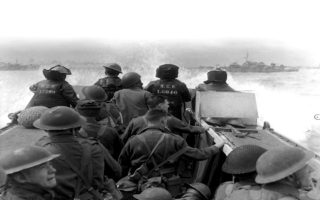
REPLY
REPLY
REPLY